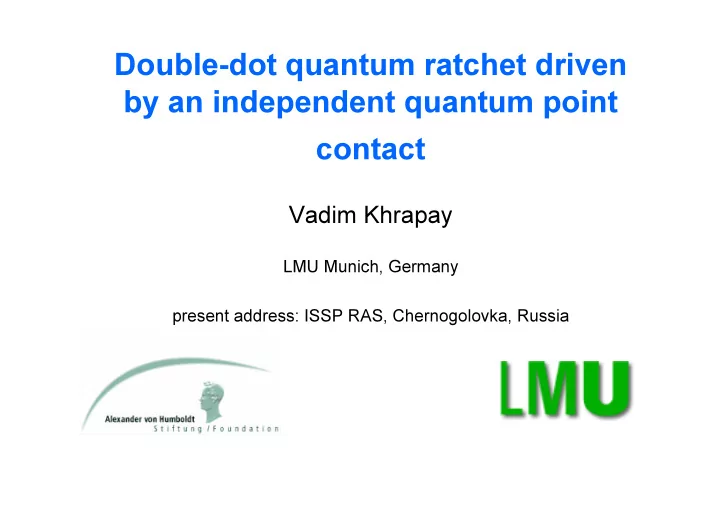

Double-dot quantum ratchet driven by an independent quantum point contact Vadim Khrapay LMU Munich, Germany present address: ISSP RAS, Chernogolovka, Russia
Classical “ratchet and a powl” Spatial asymmetry is not enough for directed motion, if thermal equilibrum is preserved Smoluchowski (1912) At Т 1 ≠ Т 2 the direction of motion depends upon the sign of asymmetry Feynman (1960)
Intro. Lateral nanostructures. Quantum point contact Gates’ electric field allows to tune the transverse energy quantization inside a 1D channel V 0 QPC Conductance quantization Ι V 0 van Wees et al. and Wharam et al. (1988)
Intro. Quantum dot (QD) Charge quantization on an almost isolated island
Intro. Quantum dot (QD) Coulomb Blockade Fluctuations of electron number on a QD is impossible at low temperature, because of the Coulomb interaction. QD is isolating. Ι V 0 Conductance oscillations lifting a blockade: V 0 E(N+1)-E(N)= µ Shechter (198?)
Intro. Double Quantum Dot Ι For current to flow the Coulomb blockade should be lifted in both serially coupled QD’s V g2 V g1 van der Wiel et al. (2003)
Intro. Double Quantum Dot [1,0] [1,1] V g2 [0,1] [0,0] V g1
Intro. Photon-assisted tunnelling in DQD [1,0] Inelastic transitions between the states localized in different dots give rise to a current in DQD, in the absence of potential |∆| difference between the leads. Resonant microwave photon absorption: h ν = ∆ van der Wiel et al. (2003) [0,1] |∆| ∆
Experiment. Nanostructure GaAs/AlGaAs heterostructure 2D layer - 90 nm benief the surface 11 cm -2 N S = 2.8x10 6 cm 2 /Vs µ =1.4x10 • Metallic gates (e-beam lytho) • 2 independent electric circuits • dc measurement • Т el < 150 mK
Experiment. Characterization. QPC QDs: Coulomb energy E C ≈ 1.5 meV • • DQD: t 0 ≈ 0.1 µ eV; Γ R , Γ L ≈ 40 µ eV • QPC: subband splitting ≈ 4 meV 1D channel onset width ≈ 1 meV
Experiment. Dynamic interaction QPC ↔ DQD I DQD measured at V DQD = -20 µ V V QPC =0 V QPC = -1.5 mV
Experiment. Dynamic interaction QPC ↔ DQD I DQD measured V DQD ≈ 0 µ V V QPC = +/_ 1.45 mV V QPC >0 2 /h G QPC ≈ e [m+1,n] Current through the DQD in the absence of • [m+1,n+1] bias Current in the Coulomb blockade regime • [m,n] Current direction is determined by the • ground state charge configuration of the [m,n+1] V QPC <0 DQD
Experiment. Inelastic tunnelling? Current sign is explained by inelastic interdot tunnelling [m+1,n] → [m,n+1] ∆ Similar to PAT [m,n+1] → [m,n] van der Wiel et al. (2003) [m,n] → [m+1,n]
Experiment. Inelastic tunnelling! Observed suppression of current between triple points X Inside the diamond the excited electron doesn’t have enough energy to leave into the Fermi sea
DQD analogous to a Quantum Ratchet Internal asymmetry of the DQD determines the direction of current −Ι −Ι µ µ µ µ [m,n] deep electrons
Experiment. Excitation spectroscopy. DQD is a tunable spectrometer |∆| = h ν Fujisawa et al. ‘98 PAT Wideband excitation (250 van der Wiel GHz) in sharp contrast to PAT et al. (2003)
Experiment. Dependence on the QPC transmission Not a Joule heating drives the ratchet! µ L µ R A eV µ L B,D eV µ R µ L C eV µ R A B C D
Experiment. Dependence on the QPC bias voltage • Direction of the DQD current is ∆ = -450 µ eV independent of the QPC bias • No effect at low bias V QPC <1 mV • Onset bias independent of ∆
QPC: ratchet excitation mechanism Maximal effect next to the bottom of 1D subbands of QPC, i.e. at T≠1 (R≠0) Occupation number fluctuations are important! • HF voltage-fluctuations on a QPC caused by shot noise? V ONSET =|V QPC |-| ∆ | / e – No energy-(frequency-) dependence of the threshold observed! Blanter and Büttiker ’00 • Relaxation of electrons inside a 1D channel?
Occupation number fluctuations could increase the relaxation rate inside a 1D channel Acoustic phonons? h ν Only a qualitative understanding of threshold-like emission is possible phonon Alternatively: Photons? 1D plasmons?
Wide energy-window for fluctuations Our QPC: 1D channel onset ≈ 1 meV wide
Concluding Novel dynamic interaction phenomenon between the • QPC and DQD Resonant energy absorption makes the DQD • equivalent to a nonadiabatic quantum ratchet Occupation number fluctuations in the QPC channel • are responsible for ratchet energization
Coauthors LMU Stefan Ludwig Jorg P. Kotthaus Uni Regensburg: H.P. Tranitz and W. Wegscheider
Acknowledgements A.W. Holleitner F. Wilhelm V.T. Dolgopolov A. Khaetskii
http://www www. .humboldt humboldt- -foundation foundation.de .de http://
Non-ratchet phenomenon observed • No ∆ dependence • ‚Anti-drag‘ direction • Acoustoelectric pumping? Levinson et al. ’00 • Nongaussian electromagnetic fluctuations?
Non-ratchet phenomenon observed • No ∆ dependence • ‚Anti-drag‘ direction • Acoustoelectric pumping? Levinson et al. ’00 • Nongaussian electromagnetic fluctuations?
Current in the double dot as a function of QPC transmission. ∆ = -450 µ eV
Observed about all the triple points I QPC = 50nA, V QPC =1.45 mV I DQD (pA) V 4 (V) V 2 (V)
Recommend
More recommend